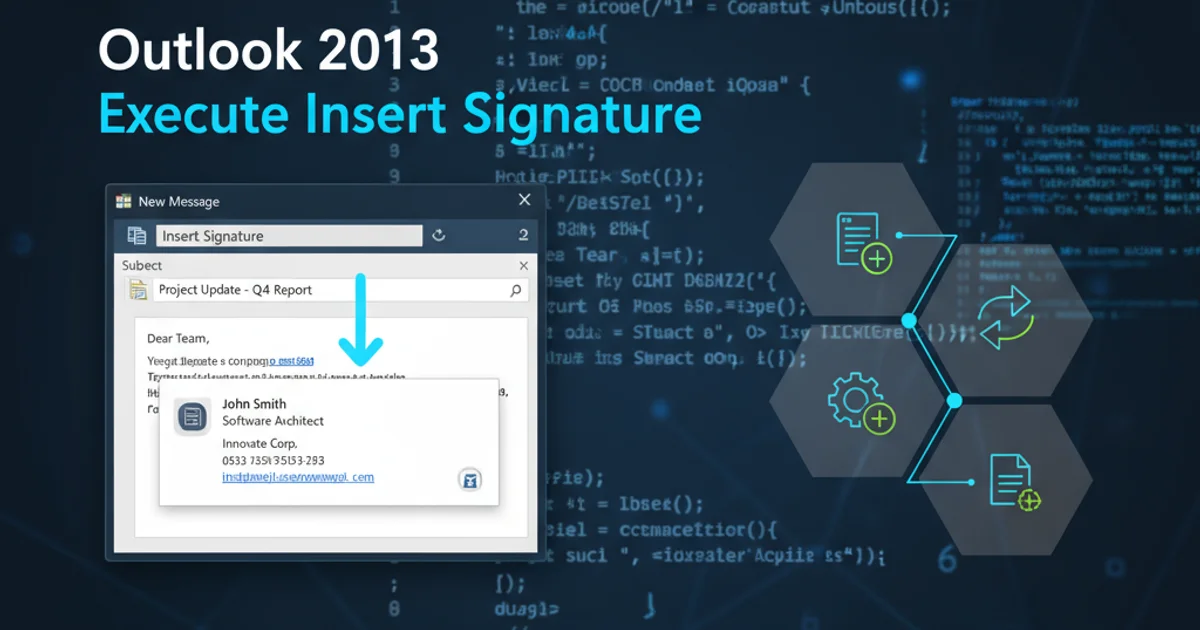Outlook 2013 Execute Insert Signature
Categories:
Automating Signature Insertion in Outlook 2013 Add-ins

Learn how to programmatically insert Outlook signatures into new emails using a C# VSTO Add-in for Outlook 2013, enhancing user productivity and ensuring consistent communication.
Integrating custom functionality into Microsoft Outlook can significantly streamline workflows. One common requirement for business users is the automatic insertion of a specific email signature when composing new messages. While Outlook provides built-in signature management, programmatically controlling signature insertion via an add-in offers greater flexibility, especially for enforcing company policies or dynamic content generation. This article will guide you through creating a C# VSTO add-in for Outlook 2013 that automatically inserts a predefined signature into new email items.
Understanding Outlook Signatures and VSTO
Outlook signatures are stored as HTML, Rich Text Format (RTF), and plain text files in a specific directory on the user's machine. When you select a signature in Outlook, it essentially loads the content from these files and inserts it into the email body. Our goal is to replicate this process programmatically using a VSTO (Visual Studio Tools for Office) add-in. VSTO allows us to extend Office applications with custom code, responding to events and manipulating application objects.
For Outlook 2013, the primary object we'll interact with is the MailItem for new emails and the Inspector for the email composition window. The key challenge lies in correctly identifying the signature files and inserting their content into the email body at the appropriate cursor position or as a replacement for existing content.
flowchart TD
A[User Clicks 'New Email'] --> B{Outlook Add-in Activated}
B --> C{New MailItem Created}
C --> D{Get Signature Path}
D --> E{Read Signature Content (HTML)}
E --> F{Insert Signature into MailItem Body}
F --> G[Email Ready with Signature]Workflow for Automatic Signature Insertion in Outlook Add-in
Implementing the Signature Insertion Logic
To insert a signature, we need to perform several steps:
- Identify the signature file: Outlook stores signatures in a specific folder. We need to locate the HTML version of the desired signature.
- Read the signature content: Load the HTML content from the signature file.
- Insert into the email: Use the
MailItem'sHTMLBodyproperty or theWordEditorof theInspectorto insert the content.
The Application_ItemSend event is not suitable for this, as it fires after the user has composed the email. Instead, we need to hook into the NewInspector event of the Application object, which fires when a new email composition window opens. This allows us to modify the email before the user starts typing.
using Outlook = Microsoft.Office.Interop.Outlook;
using System.IO;
using System.Windows.Forms;
namespace OutlookAddIn1
{
public partial class ThisAddIn
{
private void ThisAddIn_Startup(object sender, System.EventArgs e)
{
Application.Inspectors.NewInspector += Inspectors_NewInspector;
}
void Inspectors_NewInspector(Outlook.Inspector Inspector)
{
Outlook.MailItem mailItem = Inspector.CurrentItem as Outlook.MailItem;
if (mailItem != null)
{
// Check if it's a new email (not a reply or forward)
if (mailItem.EntryID == null)
{
InsertSignature(mailItem, "MyCustomSignature"); // Replace with your signature name
}
}
}
private void InsertSignature(Outlook.MailItem mailItem, string signatureName)
{
string signaturePath = GetSignatureFilePath(signatureName);
if (File.Exists(signaturePath))
{
string signatureHtml = File.ReadAllText(signaturePath);
// Prepend the signature to the existing HTML body
mailItem.HTMLBody = signatureHtml + mailItem.HTMLBody;
}
else
{
MessageBox.Show($"Signature '{signatureName}' not found.", "Signature Error", MessageBoxButtons.OK, MessageBoxIcon.Warning);
}
}
private string GetSignatureFilePath(string signatureName)
{
string appDataPath = Environment.GetFolderPath(Environment.SpecialFolder.ApplicationData);
string signatureFolder = Path.Combine(appDataPath, "Microsoft", "Signatures");
string htmlFilePath = Path.Combine(signatureFolder, signatureName + ".htm");
return htmlFilePath;
}
private void ThisAddIn_Shutdown(object sender, System.EventArgs e)
{
Application.Inspectors.NewInspector -= Inspectors_NewInspector;
}
#region VSTO generated code
/// <summary>
/// Required method for Designer support - do not modify
/// the contents of this method with the code editor.
/// </summary>
private void InternalStartup()
{
this.Startup += new System.EventHandler(ThisAddIn_Startup);
this.Shutdown += new System.EventHandler(ThisAddIn_Shutdown);
}
#endregion
}
}
C# VSTO code for inserting an Outlook signature into a new email.
InsertSignature matches the actual filename of your .htm signature file (without the extension). You can find your signature files in %APPDATA%\Microsoft\Signatures.Refinements and Considerations
The provided code offers a basic implementation. For a more robust solution, consider the following:
- Error Handling: Add more comprehensive error handling, especially for file operations and COM object interactions.
- User Configuration: Allow users to select which signature to insert, or define rules for signature selection based on the recipient or sender account.
- Placement: The current code prepends the signature. If you need to insert it at a specific cursor position or replace a placeholder, you'll need to interact with the
WordEditorobject of theInspectorto manipulate the document content more precisely. This involves using the Word object model. - Signature Types: Outlook signatures come in HTML, RTF, and plain text. This example uses the HTML version, which is generally preferred for rich formatting. If plain text is required, you would read the
.txtfile instead. - Performance: For very large signatures or frequent new email creation, optimize file reading and string manipulation.
1. Create a New VSTO Project
In Visual Studio, create a new project and select the 'Outlook 2013 Add-in' template under 'Visual C# -> Office/SharePoint -> Office Add-ins'.
2. Add Event Handler
In the ThisAddIn.cs file, add the Inspectors_NewInspector event handler to the ThisAddIn_Startup method to listen for new email windows.
3. Implement Signature Logic
Implement the InsertSignature and GetSignatureFilePath methods as shown in the code example. Remember to replace "MyCustomSignature" with the actual name of your desired Outlook signature.
4. Build and Test
Build your project and run it. When you create a new email in Outlook, your add-in should automatically insert the specified signature.